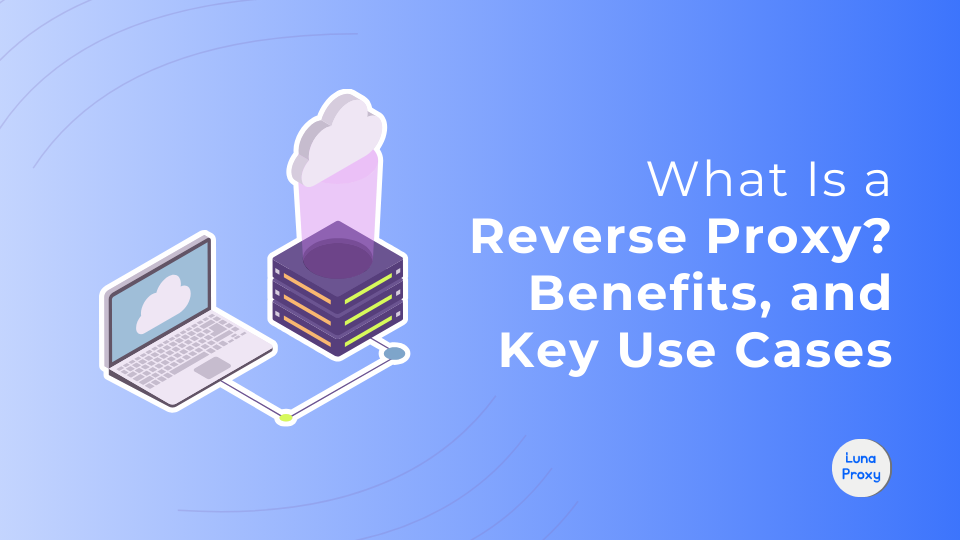
Reverse proxies are one of the key tools that help ensure network management security and performance. But what exactly is a reverse proxy? How does it work? In this blog post, we’ll dive into the basics of reverse proxies, their benefits, and some common use cases that demonstrate their importance in the modern web.

What is a reverse proxy?
A reverse proxy is a server that sits between the client device and the backend server, acting as an intermediary for the client to send requests. Unlike traditional proxies that forward client requests to a server, a reverse proxy intercepts incoming requests, directs them to the appropriate backend server, and returns the server's response to the client.
Simply put, a reverse proxy can be thought of as a traffic controller for server requests. It sits in front of your backend servers, protecting them from direct contact with clients, which helps improve security, load balancing, and performance.
How does a reverse proxy work?
When a client (such as a user's web browser) makes a request to a website or application, a reverse proxy intercepts the request before it reaches the backend server. Then, reverse proxy:
Review and verify requests to ensure they are secure and appropriate.
Forward the request to one or more backend servers for processing.
Return the server's response to the client, making it appear as if the proxy itself is the server.
Benefits of using a reverse proxy
Reverse proxies offer a variety of benefits, from increased security to optimized performance. Let’s explore these benefits in detail:
Enhance security
One of the main reasons organizations use reverse proxies is to enhance security. Reverse proxy:
Hide backend servers: A reverse proxy acts as a shield, hiding the identity and location of backend servers, making it harder for attackers to attack them directly.
DDoS attack mitigation: They can detect and block malicious requests before they reach your backend servers, reducing the risk of distributed denial-of-service (DDoS) attacks.
Encrypted data: A reverse proxy can handle Secure Sockets Layer (SSL) encryption, offloading this process from the backend server and ensuring secure data transfer between the client and server.
Load balancing and performance improvements
A reverse proxy distributes incoming client requests to multiple backend servers, which helps:
Balanced server load: By evenly distributing requests, a reverse proxy prevents any single server from being overloaded, ensuring consistent performance.
Reduce server downtime: If one server fails, a reverse proxy can redirect requests to other running servers, minimizing downtime and maintaining user access.
Optimized content delivery: Reverse proxies cache frequently requested content, speeding up response times for subsequent requests and reducing load on backend servers.
Scalability
Reverse proxies enable networks to scale more efficiently by:
Add or remove servers: They can easily add or remove backend servers as needed without disrupting service to end users, allowing for seamless scaling to handle traffic spikes.
Increased redundancy: By distributing traffic among multiple servers, a reverse proxy ensures that the failure of one server does not affect the entire service.
Main use cases for reverse proxies
Now that we understand the benefits of reverse proxies, let’s look at some practical scenarios where they are commonly used.
Load balancing for high-traffic websites
Websites and applications with high traffic volume, such as e-commerce platforms or popular media sites, rely on reverse proxies for load balancing. By distributing incoming requests across multiple servers, reverse proxies help maintain consistent performance and prevent server overload, ensuring a smooth user experience even during peak traffic periods.
Enhance the security of financial and medical services
Industries that handle sensitive data, such as finance and healthcare, often use reverse proxies to enhance security. Reverse proxies protect backend servers from direct exposure to the Internet, thereby reducing the risk of attacks on sensitive data.
Optimizing content delivery for media streaming services
Media streaming services benefit from reverse proxies through content caching. By storing frequently requested media files, reverse proxies can serve content to users faster while reducing the load on backend servers.
Support microservice architecture
In a microservices architecture, applications are divided into small, loosely coupled services that communicate over a network. Reverse proxies help in the following ways:
Route requests: Direct client requests to the appropriate microservices, enabling smooth inter-service communication.
Manage service discovery: By maintaining a list of active services, a reverse proxy ensures that client requests are sent to the correct service instance.
Challenges and considerations when using reverse proxies
While reverse proxies offer many advantages, there are also some challenges to consider:
Configuration complexity
Setting up and managing a reverse proxy can be complex, especially for organizations with limited IT resources. Proper configuration is critical to ensuring traffic is routed correctly and security measures are implemented effectively.
Latency issues
Adding a reverse proxy to your network introduces extra steps into the request and response process, which can increase latency. However, with proper configuration and optimization, this impact is usually minimal and can often be compensated for by the performance improvements provided by caching and load balancing.
single point of failure
As the central point through which all traffic passes, a reverse proxy can become a single point of failure. Implementing failover mechanisms and redundant agents can mitigate this risk and ensure continued service availability.
in conclusion
A reverse proxy is a powerful tool that provides numerous benefits, from improved security and load balancing to optimized content delivery and simplified management tasks. By understanding how reverse proxies work and identifying key use cases, enterprises can leverage them to enhance the performance, scalability, and security of their networks. Whether you run a high-traffic website, manage sensitive data, or support a microservices architecture, a reverse proxy can play a critical role in achieving your network management goals.
When implementing a reverse proxy, be aware of potential challenges and choose a solution that meets your organization's specific requirements. With the right setup, reverse proxies can be a valuable asset in ensuring a secure, resilient, and efficient network infrastructure.







































